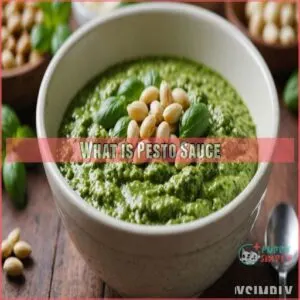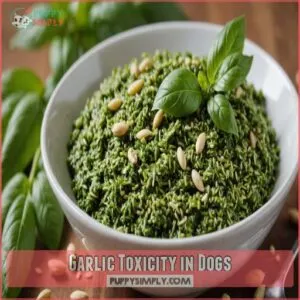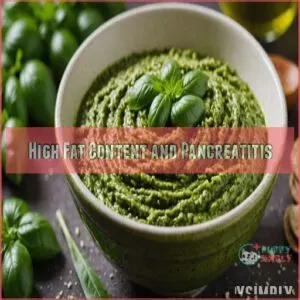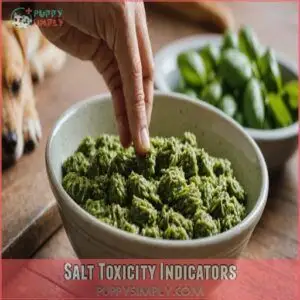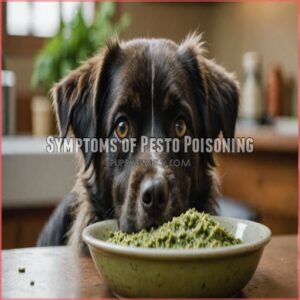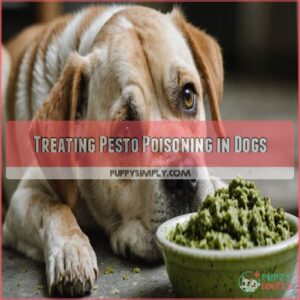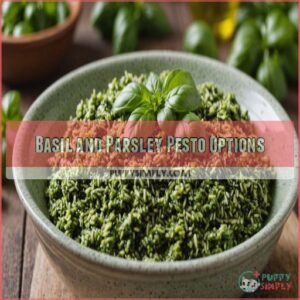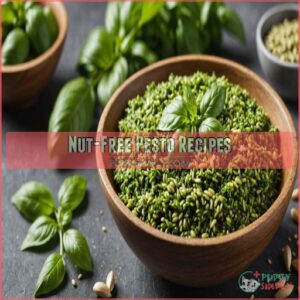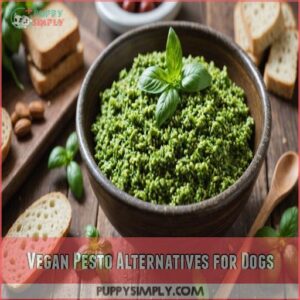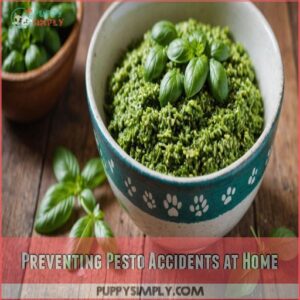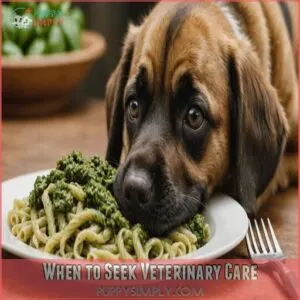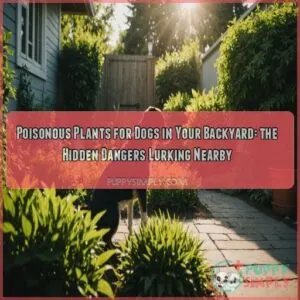This site is supported by our readers. We may earn a commission, at no cost to you, if you purchase through links.
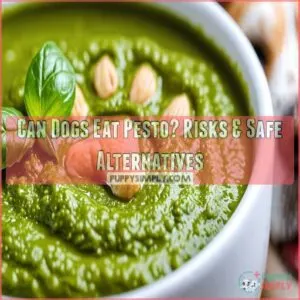 You might think sharing pesto sauce with your dog is harmless, but think twice!
You might think sharing pesto sauce with your dog is harmless, but think twice!
While it’s tasty on pasta, pesto’s ingredients can spell trouble for your furry buddy.
With garlic being toxic and fatty oils and cheese posing risks like pancreatitis, it’s best to keep this green delight away from them.
Watch for signs of garlic poisoning or an upset tummy if your pup sneaks a taste.
Instead, consider dog-friendly alternatives that’ll keep tails wagging.
So, can dogs eat pesto sauce? Not a good idea.
Curious about safer options? Stick around for some pawsitively delicious tips!
Table Of Contents
- Key Takeaways
- What is Pesto Sauce
- Risks of Pesto Sauce for Dogs
- Symptoms of Pesto Poisoning
- Treating Pesto Poisoning in Dogs
- Making Dog-Safe Pesto Alternatives
- Preventing Pesto Accidents at Home
- When to Seek Veterinary Care
- Frequently Asked Questions (FAQs)
- Can dogs eat pesto sauce?
- Is pesto high in carbohydrates?
- Can dogs eat pesto?
- Can dogs eat pasta sauce?
- Can dogs eat basil pesto?
- Can dogs eat pizza sauce?
- Is pesto allowed for dogs?
- What happens if my dog eats pine nuts?
- Can dogs have basil?
- Are there any sauces dogs can eat?
- Can puppies safely consume pesto sauce?
- What should I do if my dog eats store-bought pesto?
- Are there pesto varieties safer for dogs?
- How much pesto is dangerous for dogs?
- Can pesto trigger allergies in dogs?
- Conclusion
Key Takeaways
- Pesto sauce is unsafe for dogs due to its garlic content, which is toxic.
- High fat and salt levels in pesto can cause pancreatitis, weight gain, and kidney problems.
- If your dog eats pesto, watch for vomiting, diarrhea, lethargy, or abdominal pain; contact your vet immediately if these occur.
- You can make dog-safe pesto alternatives using basil, parsley, and safe herbs, omitting garlic, nuts, and cheese.
What is Pesto Sauce
Pesto sauce, a staple of Italian cuisine, is made with garlic, pine nuts, basil, cheese, and olive oil.
It’s delicious on pasta, but since many pesto recipes include onions, which can be highly toxic to dogs, its ingredients can pose health risks for dogs, so it’s best to keep it out of their reach.
Ingredients in Traditional Pesto
Imagine you’re crafting a classic pesto sauce, mixing fresh basil leaves, pine nuts, Parmesan cheese, and olive oil, all of which can be found at stores selling pesto ingredients online.
The harmony of these simple ingredients creates a delightful, savory blend.
However, what’s a treat for humans isn’t always safe for our furry pals.
The salt content in pesto, along with its rich flavors, means it’s not ideal for dogs.
While basil might be harmless, traditional pesto can be risky when dogs eat pesto.
Risks of Pesto Ingredients for Dogs
You might wonder, can dogs safely enjoy pesto? Most of the time, the answer is no. Feeding dogs hot dogs with high salt content can lead to dehydration and high blood pressure, as discussed in the effects of can dogs eat weiners. Pesto ingredients like garlic and pine nuts pose risks to dog health. Here’s why you should keep pesto away from your furry friend:
- Garlic toxicity can damage red blood cells.
- High salt content harms a dog’s kidney.
- Excess fat leads to weight gain.
- Cheese introduces dietary safety concerns.
- Basil is generally safe but in moderation.
Risks of Pesto Sauce for Dogs
Feeding your dog pesto sauce isn’t safe, as it contains garlic that’s toxic to dogs, as well as high fat and salt levels that can cause health issues.
Pesto contains garlic, which is toxic to dogs.
High fat and salt levels in pesto can also cause health problems for dogs.
Keep an eye out for symptoms like lethargy and gastrointestinal upset, and contact your vet if your pup accidentally consumes pesto.
Garlic Toxicity in Dogs
Regarding feeding your dog, garlic in pesto is a big no-no.
This familiar spice, while delicious to us, can cause garlic toxicity, damaging their red blood cells.
Symptoms might include garlic poisoning levels of anemia, lethargy, and loss of appetite.
Opt for garlic substitutes or safe herbs instead.
Remember, dogs eat herbs safely, not garlic.
High Fat Content and Pancreatitis
High fat content in pesto can spell trouble for dogs, upping pancreatitis risk factors.
Keep an eye on dietary fat limits to prevent this painful condition.
High-fat diet dangers sneak up like pine nuts in pesto sauce.
Reducing fatty foods helps with pancreatitis prevention.
Many dog food brands offer options to manage fat levels, ensuring your pup stays healthy and happy.
Cheese and Dairy Issues
Although pesto often includes cheese, it’s not always a good idea for your pup.
Many dogs suffer from lactose intolerance or dairy allergies.
Here’s what you should know:
- Lactose intolerance leads to digestive upset.
- Dairy allergies can cause more serious reactions.
- Consider cheese alternatives like yogurt (in moderation).
Remember, a little parmesan cheese isn’t usually a big deal, but moderation is key.
Always prioritize your dog’s health!
Salt Toxicity Indicators
When it comes to pesto-loving dogs, salt toxicity is a sneaky adversary.
Pesto’s high salt can cause dog health problems like lethargy, appetite loss, and kidney dysfunction.
Monitor salt toxicity indicators and make sure your dog has plenty of water to drink.
Here’s a quick salt toxicity guide:
| Indicator | Description | Impact |
|---|---|---|
| Lethargy | Reduced energy levels | Lower activity |
| Appetite Loss | Declining interest in food | Nutrient deficit |
| Kidney Issues | Impaired kidney function | Health decline |
Keep an eye out, and your furry friend will tail-wag into good health!
Symptoms of Pesto Poisoning
If your dog gets into some pesto, you might notice signs like vomiting, diarrhea, or fatigue, which can point to garlic poisoning.
Additionally, keep an eye out for symptoms of pancreatitis or gastrointestinal upset, both of which require prompt attention.
Garlic Poisoning Signs in Dogs
Signs of garlic poisoning in dogs often appear subtle at first yet quickly escalate.
Look out for symptoms like vomiting, diarrhea, and lethargy.
These symptoms are important clues.
The culprit? Garlic, with its stealthy thiosulfate, damages red blood cells, leading to anemia.
If your dog nibbled on pesto or you suspect garlic ingestion, consult your vet promptly for guidance.
Pancreatitis Symptoms in Dogs
When your dog indulges in pesto, the high-fat content can trigger pancreatitis.
You’ll notice symptoms like vomiting, lethargy, and abdominal pain.
It’s as if your furry friend just can’t catch a break.
Prompt veterinary attention is essential for treatment, which might include a specialized pancreatitis diet and other supportive care.
Prevention is key, so keep that pesto out of reach!
Gastrointestinal Upset Symptoms
After noticing your pup’s unusual lethargy from pancreatitis, pesto sauce might stir gastrointestinal turmoil due to its high fat content, which can lead to obesity and digestive issues, as explained in the guide on Pesto Toxicity Symptoms.
Your dog could display symptoms like vomiting and diarrhea, often accompanied by abdominal pain and nausea, easily leading to dehydration.
Imagine their stomach doing cartwheels! It’s unsettling, but knowing these signs helps you act swiftly.
A quick chat with the vet can help your furry friend recover quickly.
Treating Pesto Poisoning in Dogs
When your dog munches on pesto, quick action can help prevent a crisis.
Consult your vet before inducing vomiting or using activated charcoal.
Follow up with supportive care like IV fluids and a bland diet.
Inducing Vomiting and Activated Charcoal
Seeing your dog unwell is scary.
If you suspect pesto poisoning, don’t panic! However, before trying home remedies for pesto poisoning, always call your vet.
They can advise on the best course of action.
Here’s what they might suggest:
- Inducing vomiting.
- Administering activated charcoal.
- Close monitoring of your dog’s condition.
- Following their specific instructions.
Feeding human foods like hot dogs are toxic to pets can cause serious health issues. Remember, vet advice is key for dog safety!
Supportive Care and Monitoring
Keeping an eye on your dog after pesto mishaps is important.
Engage in fluid therapy and medication management under a vet’s guidance.
Perform regular vital sign checks.
Watch for vomiting or diarrhea, signaling gastrointestinal upset.
Behavioral observations can clue you into discomfort or lethargy.
This supportive care helps your furry friend stay wagging and well, even in culinary misadventures.
Feeding a Bland Diet
Wondering how to help your pup after they’ve had too much pesto?
Try feeding them a bland diet, like boiled chicken and rice, to soothe their stomach upset.
This homemade recovery food eases digestive issues and nurtures their healing process.
Avoid garlic pesto sauce during recovery to prevent further gastrointestinal upset, and always check pesto ingredients for dog-safe options.
Making Dog-Safe Pesto Alternatives
You can whip up dog-safe pesto by blending basil or parsley with ingredients your pup can enjoy, like spinach or carrots, without any nuts or cheese.
These alternatives offer a tasty, healthy treat, ensuring your canine companion stays safe and satisfied.
Basil and Parsley Pesto Options
To whip up a dog-safe pesto, ditch the garlic and cheese, then grab basil and parsley instead.
These herbs are safe but also beneficial for your furry friend.
Mix them with olive oil and dog-approved nuts, blending up a simple, homemade pesto.
Your pup can enjoy this tasty treat without the risks hidden in traditional recipes.
Nut-Free Pesto Recipes
Want to whip up a dog-safe pesto without nuts?
Try swapping pine nuts for sunflower or pumpkin seeds to keep the crunch but not the risk.
You can also explore store-bought nut-free options at nut free pesto products.
Mix in basil and parsley, and you’ve got a nut-free pesto variation.
Remember, skip the garlic, opt for a splash of low-sodium broth, and you’re golden.
Who knew pesto could be pet-friendly?
Vegan Pesto Alternatives for Dogs
After exploring nut-free pesto options, let’s shake things up with vegan pesto alternatives for your furry friend.
Opt for dog-friendly ingredients like basil, parsley, and safe herbs, sparing the garlic and pine nuts, which can cause common symptoms of pesto poisoning.
Blend them with water or low-sodium broth for a tasty garlic-free treat.
It’s perfect for picky eaters and keeps tails wagging with wag-worthy flavors!
Preventing Pesto Accidents at Home
Let’s keep pesto away from your furry friend; safe storage and mindful eating habits are key to preventing pesto-related problems for your dog.
Pet-Proofing The Kitchen and Dining
Keeping your kitchen dog-proof is simpler than you think.
Securing foods like grapes which can lead to acute sudden kidney failure makes securing pesto and other toxic foods crucial to ensure your furry friend stays safe.
Start with these tips:
- Dog-proof storage: Use child-proof latches on cabinets.
- Countertop safety: Keep surfaces clear of food, including pesto sauce.
- Pet-safe cleaning: Promptly clean spills to prevent floor hazards.
Creating a safe dining area prevents accidents.
Proper Food Storage and Disposal
While pet-proofing your kitchen, think about storing food safely.
Use pet-safe containers to keep pesto sauce away from curious noses.
Regular countertop clean-up helps prevent pesto accidents.
Consider purchasing doggy trash bins online, such as heavy duty doggy trash bins, for keeping garbage secure.
Invest in doggy trash bins that resist tip-overs to keep garbage, such as spoons with toxic ingredients, secure.
These food storage tips help create kitchen safety, protecting your pet from garlic, pine nuts, and parmesan cheese mishaps.
Educating Family Members on Pesto Risks
Share pesto dangers with your family in a friendly chat about keeping pets safe.
Emphasize kitchen rules and open communication for everyone’s peace of mind.
Explain why garlic and parmesan cheese aren’t dog-friendly, and remind them to be cautious with other foods, such as nuts safe for dogs.
Discuss pet-safe alternatives for shared meals.
Set clear kitchen zones for food prep.
Encourage ongoing discussions about safety tips.
When to Seek Veterinary Care
If your dog has ingested pesto, it’s important to monitor for any unusual symptoms like vomiting or lethargy, and seek immediate veterinary care if these occur.
Regular check-ups are essential for catching any issues early and ensuring your pet stays healthy, even if they sneakily munch on something they shouldn’t.
Emergency Situations and Pesto Ingestion
Left some pesto within reach?
If your dog gobbles it up, it’s time to spring into action.
Pesto ingestion can be compared to eating other high-fat and sodium foods like cured meats like prosciutto, which can lead to serious dog health issues like pesto toxicity.
Watch for signs of distress and don’t hesitate to seek emergency care.
A vet visit could save your pup’s life.
Remember, prompt first aid and veterinarian advice are your best friends here.
Monitoring for Symptoms and Complications
Spotting pesto poisoning early, keep a close eye on your dog’s health after any pesto adventure.
Look for signs like vomiting, diarrhea, or lethargy.
Garlic can trigger anemia, while pesto sauce might lead to other dog health issues.
If symptoms persist or worsen, it’s time for a vet visit.
Quick action can make all the difference in their recovery timeline.
Regular Check-Ups and Preventative Care
Regular vet visits are key for your dog’s health. Annual exams help catch problems early.
Vaccinations protect against diseases, and parasite prevention keeps those pesky critters away. Think of it as preventative maintenance for your furry friend!
Early detection is essential; it’s much easier (and cheaper!) to address minor issues before they become major ones. Don’t wait until your dog’s feeling poorly; schedule those checkups!
Frequently Asked Questions (FAQs)
Can dogs eat pesto sauce?
Back in the day, folks didn’t have to tell pups to avoid rich foods like pesto, but here we’re warning about garlic’s danger to dogs.
Garlic and fat content in pesto makes it unsafe for pups.
Is pesto high in carbohydrates?
Pesto isn’t high in carbohydrates; it’s mainly composed of fat from olive oil and nuts.
Its smooth, rich texture contributes more to fat intake.
Make sure you track the ingredient list if carbs concern you.
Can dogs eat pesto?
Dogs shouldn’t eat pesto because garlic in it’s toxic, potentially causing anemia.
Pesto’s high fat and salt content aren’t good for dogs either.
Always check with your vet before introducing new foods to your dog.
Can dogs eat pasta sauce?
Imagine a delicious plate of pasta!
Most pasta sauces aren’t toxic, but onions or garlic can be.
Always check ingredients; a little plain sauce is usually okay, but moderation’s key for your pup’s tummy.
Can dogs eat basil pesto?
Feeding your dog basil pesto isn’t a great idea.
It often contains garlic, which is toxic to dogs, and is high in salt and fat.
These ingredients can lead to health issues, so it’s best avoided.
Can dogs eat pizza sauce?
Pizza sauce isn’t safe for dogs due to common ingredients like onions and garlic, which are toxic.
These can harm your furry friend’s red blood cells, causing anemia.
Stick to dog-safe treats and consult your vet.
Is pesto allowed for dogs?
Pesto isn’t safe for dogs because it often contains garlic, which is toxic.
It also contains high levels of salt and fat.
Both can cause serious health issues, so it’s best to avoid sharing pesto with your furry friend.
What happens if my dog eats pine nuts?
When the cat’s away, your dog might munch on pine nuts.
Thankfully, they’re not toxic, but they can be high in fat, leading to tummy troubles like vomiting or diarrhea if Fido eats too many.
Can dogs have basil?
Dogs can safely munch on basil in small amounts.
It’s a tasty herb that might help calm anxious pups, adding a dash of flavor without the drama.
Just don’t overdo it; moderation’s key for a happy hound.
Are there any sauces dogs can eat?
Many sauces are unsafe for dogs; garlic, onions, and high salt content are common culprits. Always check ingredients before sharing. Plain, unsalted broths are safer options.
Can puppies safely consume pesto sauce?
Pesto sauce isn’t safe for puppies due to garlic, which is toxic and harmful.
Also, its high salt and fat content can upset their delicate stomachs.
It’s best to keep pesto out of their diet.
What should I do if my dog eats store-bought pesto?
First, check for symptoms like vomiting or lethargy.
Store-bought pesto often contains garlic, which is toxic to dogs.
Contact your vet immediately for advice; they might suggest visiting the clinic or monitoring your dog’s condition closely.
Are there pesto varieties safer for dogs?
You can make garlic-free pesto at home for your dog.
Use safe ingredients like parsley, basil, pine nuts, and low-sodium broth.
Even then, serve it sparingly to avoid any potential tummy troubles.
Always consult your vet.
How much pesto is dangerous for dogs?
A small amount of pesto can harm dogs due to garlic toxicity.
Even a spoonful can trigger symptoms like vomiting or diarrhea.
Promptly consult a vet if your furry friend has indulged in any pesto.
Can pesto trigger allergies in dogs?
Imagine your dog’s tail wagging like a flag in the wind, then suddenly stopping due to allergies.
Pesto can indeed trigger allergies in dogs, mainly due to its ingredients like garlic or nuts.
Always consult a vet.
Conclusion
Thinking of sharing pesto with your dog might seem innocent—until you remember it’s a recipe for disaster.
With garlic and high-fat content, pesto’s not the treat you’d hope for your furry friend.
Signs of illness like vomiting and diarrhea could mean pesto poisoning, sending you straight to the vet.
Instead, consider dog-friendly, nut-free pesto alternatives.
Make sure your pup enjoys safe, delicious snacks without the risk by keeping pesto out of reach.

